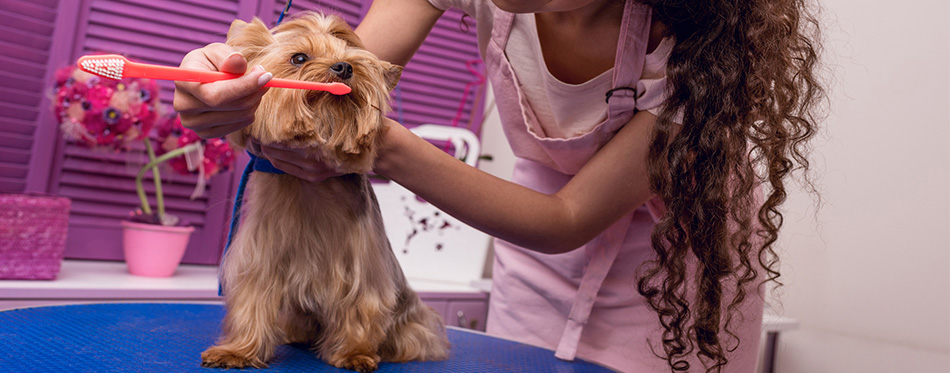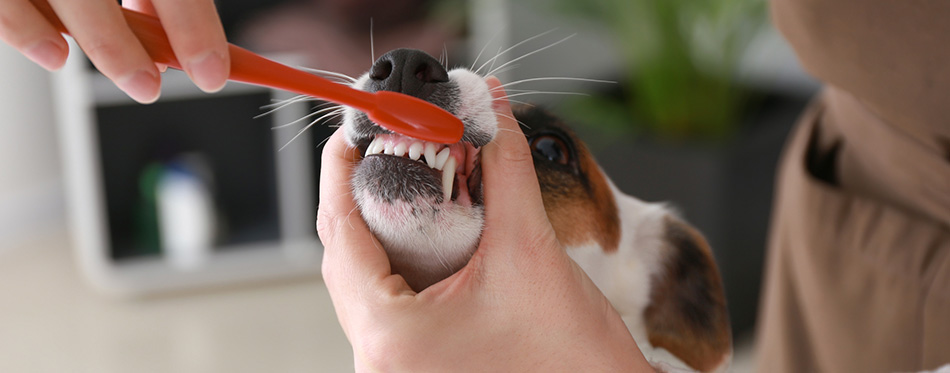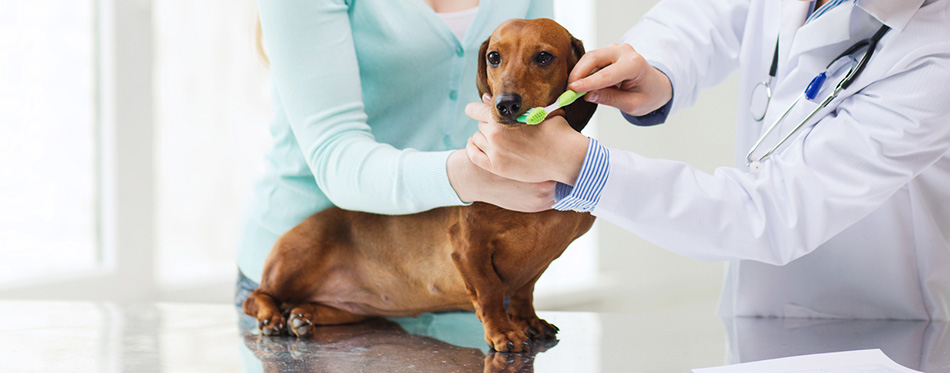Brushing your dog’s teeth is one of the best ways you can actively help your dog to stay healthy. By the time they are four, most dogs exhibit signs of gum disease, the first signal of which is bad breath. Gum disease is a far more serious condition than most pet owners realise. This is because it can develop into much worse illnesses that will seriously affect your dog.
Here we look at how to brush your teeth and what regular teeth brushing protects your dog from contracting.

How to Clean Your Dog’s Teeth at Home
The following steps are some great tips on how to clean your dog’s teeth at home. The logistics of it are not always the easiest, often thanks to a wriggly subject, but sticking at it will mean that they eventually get used to it. The earlier you start brushing a dog’s teeth the better – not only does it mean their gums are healthier from a younger age, it also means that they are more pliable and less set in their ways so the overall routine becomes much easier. Hopefully, in the long wrong your dog will become comfortable with the process of having his or her teeth cleaned.
- Never use a human toothbrush for this job. Instead, use a brush that is specially made for a dog’s mouth and teeth.
- Do not use human toothpaste as it is bad for dogs. In the same way that there are dog friendly toothbrushes, make certain that you buy and use a dog friendly toothpaste. You’ll notice that this probably isn’t minty fresh! Instead, it will be flavoured in a way to keep your dog happy.
- Before you start brushing, try to give your dog a small amount of the toothpaste first. In this way, you will be getting your pet used to the taste, which should make the overall experience a little easier once they realise it tastes delicious to them.
- To start brushing, you need to be able to see your dog’s gums and teeth. To do so, lift his or her lips first.
- Now start brushing, in a not too dissimilar way to how you would brush your own. Ensure you use gentle brush strokes to protect against gum recession and make it a bit more tolerable for your pooch.
- Usually, most dogs will only really allow their owners to clean the outside surfaces of their teeth and not the ones on the inside next to their tongue.
- Make sure you reach all teeth. This includes getting to the back teeth like the upper molars as well as the canines. It is these that can see the quickest build up of tartar.
- Finally, when you are finished, ensure that you give your dog a treat for being so well behaved. Having just done their teeth, it is probably best to steer clear of a food related reward for once, so try playing with them or giving them their favourite toy. Some dogs will simply love a good cuddle.
In rewarding them, you are positively reinforcing their good behaviour so it pays to build this step into the teeth brushing process as it needs to be carried out regularly.
Follow these steps as often as often as possible and hopefully your dog should allow you to brush their teeth more and more regularly, with increasing ease.
When to Know to Brush Your Dog’s Teeth
The following two signs means that it is a good idea to brush your dog’s teeth. They can mean the start of gum disease through the buildup of plaque and tartar on their teeth and gum line.
- Smelly Breath
- Red and Painful Looking Gums
When to Take Your Dog to the Vet
The following signs and symptoms means you should go to the vet straight away for a health consultation. They are key signs of the development of gum disease which can then turn into something far worse, if they haven’t already.
- Excessive Drooling
- Tumours In Gums
- Inflamed Gums
- Cysts Under Tongue

Brushing Your Dog’s Teeth Can Protect Against These Diseases and Conditions
By knowing what diseases and illnesses dogs can develop and contract from the beginnings of gum disease, as owners we will be far more willing to broach the subject of brushing their teeth with them – something that not even the most placid of dogs take to very easily.
- Periodontal Disease
Periodontal disease can actually be quite serious if it is not treated early enough. It is caused by food being caught in between teeth to cause a buildup of tartar. It can result in tooth loss through infection of the gums which can sadly spread to the rest of the body to cause sickness. Symptoms of periodontal disease include sneezing, nasal discharge, bad breath and toothache.
- Swollen and Inflamed Gums
Just like in humans, swollen and inflamed gums are a direct symptom of inadequate toothbrushing. Gums can bleed and be sore as well as painful if the problem is not addressed, not to mention it being one of the first signs of gum disease. It is caused by a buildup of tartar that comes from food being lodged in between teeth.
- Bad Breath
While halitosis is not a deadly condition, it’s a good signal that your dog needs to have his teeth brushed to save against gum disease. Plus, it’s simply not very pleasant for you or your four legged best friend to have smelly breath all day every day. Check out our guide on dog dental spray for more info.
- Gingivitis
This is a serious form of gum inflammation that comes from too much plaque and tartar building up in and around the teeth causing pain for the gums. Bacteria is produced that worsens the problem and can grow both above and below the gum line. Bad breath and a bleeding mouth are common symptoms, amongst others – all of which can be stopped by regular brushing.
- Mouth tumors
These need to be examined by a vet immediately so that if a tumour is malignant, it can be dealt with as soon as medically possible. Mouth tumours in dogs look like lumps in and around their gums. Even before the severity or size of the tumours are taken into account, they can be quite painful for your pup, which may have resulted in a loss of appetite.
- Saliva Cysts
This are painful collections of saliva under the tongue but they also sometimes form in the corner of the mouth. They will look like blisters. If you notice one you will need to go to the vet to have them drained professionally. They can be quite sore for your dog so it’s best to have them seen to straight away so there is no loss of appetite or further infection.

- Tooth Loss
While it is quite common for dogs to lose teeth to gum infection and disease, it does not mean it is ok! Tooth loss will either come from a vet surgically removing a tooth or from the tooth simply falling out after so much gum damage has developed.
It is easy to see therefore why it is imperative to at least try to brush your dog’s teeth as regularly as possible. It is certainly no easy task but by following our steps and tips on how to brush your dog’s teeth, you will at least be part way down the road to better oral hygiene for your pup. The seriousness of gum disease really should never be underrated and certainly never overlooked. As stated above, given the severity of the conditions that can develop, ignoring it can be dangerous. As it is such an easy disease to prevent, simply by brushing teeth at home regularly it is foolish of owners to at least not try.
Other ways that owners can help in the prevention of tartar and plaque buildup is to regularly give their dogs chew toys and rawhide. Toys can help push away tartar that has yet to turn into hard plaque that can be such a key cause of gum disease. Edible chew toys like rawhide however should be used in a limited supply given the high calorie count of them. Furthermore, limit the amount of table scraps and other food that is given to your dog outside his normal kibble or food. Kibble is designed and formulated to keep tartar under control so it is best for your dog to keep this as his main source of food. The same can be said of treats – if you want to reward your dog, do so with treats that were made with a dog’s teeth in mind.
Take a look at our review of the Best Dog Chews and Best Rawhide for Dogs for more info.
By following all these tips, your dog should start to enjoy better oral hygiene for a longer, healthier, happier life.
Sources:
- How To Brush a Dog’s Teeth – Carrington College
- Toothbrushing Steps To Make Dog Teeth Dazzle – AKC
- How to Brush Your Dog’s Teeth – mspca angell

